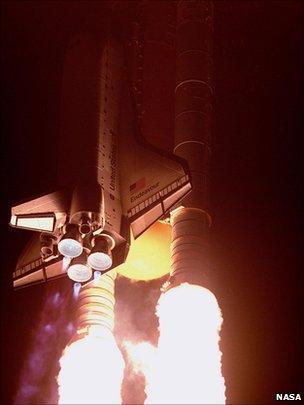Shuttle launch: The thrill of the ascent
- Published
- comments

The raw power of shuttle on lift-off
Every grass verge and every beach here on the Space Coast will be packed with spectators on Friday.
Estimates suggest half a million to three-quarters of a million people will try to get close to the Kennedy Space Center to watch the final launch of a shuttle.
Atlantis is due to thunder off the pad at 1126 local time, engineering gremlins and Florida's fickle weather permitting.
It's not just a piece of history everyone wants to witness; it's the desire also to experience the thrill of the ascent.
I've been fortunate to see a few shuttle launches, and there really is nothing to compare with the sight, sound and the feeling of being up-close to 2,000 tonnes of machine as it gets up off the Earth.
The brilliance of the light is the first thing that strikes you, followed by a deafening popping sound.
And then you feel it; your whole body vibrates… along with all the vehicles in the Kennedy's viewing area car park which immediately start hooting because their alarms have sensed a disturbance.
That's what it's like from the outside; I can only imagine what it must be like sitting inside a shuttle.
Speak to any astronaut and they'll assure you that their first concern is focussing on the job, or the instruments… but they'll also admit to the excitement.
"You do try to take a quick look out the window and watch the state of Florida and see the United States disappear, and it is an absolutely magical feeling," says Chris Ferguson, who will command Atlantis on its final mission.
The space shuttle's thrust at lift off comes from those two white solid rocket boosters and the vehicle's three main engines. Together they provide about 34 meganewtons (7.8 million pounds). The orbiter accelerates from zero to a speed of almost 28,000 km per hour (18,000 miles per hour) in eight and a half minutes. The final speed achieved is equivalent to nine times that of the average rifle bullet.
No wonder Rex Walheim, a mission specialist on Atlantis, says he's "a window seat kind of guy, even to this day I love when I go on an airplane - I gotta have a window seat. The absolute window seat is on the space shuttle and it really is an amazing."
The main engines are the first things to light, and the astronauts talk about the "twang" that occurs at that moment.
"Because the main engines are not right on the centre of gravity, the whole stack twangs; it moves," says Steven Lindsey, the commander on Discovery's final flight earlier this year.
"The engineers have it timed exactly so that when the stack twangs back to the centre, the solid rocket boosters light. And when they light - those are three million pounds of thrust each - it kicks you back into your seat with 2.6 to 2.7Gs, and you are gone."

The first two minutes are a little rough
The first two minutes of the flight are the hardest on the astronauts as the shuttle lifts up, rolls on to its back and heads out over the Atlantic for its chase to the International Space Station.
"There's a rapid shaking left and right," recalls UK-born astronaut Michael Foale. "As this roar develops, you realise 'I can't read the instruments; I thought I was meant to do a job here'!
"Those two minutes while the boosters are firing - you also hear a noise outside that's extraordinary. It's a kind of groaning, roaring, moaning noise as the winds picks up outside the shuttle," he tells me.
Release comes when the solids get to the end of their burn and are jettisoned.
"On the video it looks so graceful as they depart the vehicle," says Walheim, "but when you are inside, it is a little bit like a train wreck. It bangs as explosive bolts go off, and the thrusters that push those rockets away from you - they have flames and orange that goes around your windows and sometimes you get some exhaust on the windshield, and you just go 'wow!'".
Foale describes this moment as when "the gorilla gets off your chest", and things go quiet. But the flight is barely a quarter done.
"It's another six and a half minutes up to orbit. We pitch over and actually descend a little to accelerate more," says Lindsey. "Then, as we start using up more and more of the hydrogen and oxygen propellant in the external tank, the vehicle gets lighter and lighter and we start accelerating faster and faster.
"We accelerate all the way up to 3Gs about a minute prior to Main Engine Cut-Off."
Just over 350 different individuals have flown on the shuttle in its 30-year history. That's not many people - a select group who've experienced one of the greatest rides ever devised.